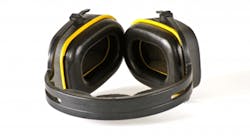Off-the-Job Safety: Protecting Your Hearing at Home and Play
It’s summertime and the living is noisy. In fact, some of the most familiar sounds of season – sporting events (117 dB), rock concerts (120 dB), motorcycles (105 dB), chainsaws (118 dB), lawnmowers (94 dB) and power tools (93 dB) – can generate as much (or even more) noise than the typical workplace, where an array of regulations and hearing protection devices help workers avoid noise-induced hearing loss.
The danger is that when we’re at home, we often don’t think about noise as being hazardous – or that we’re putting ourselves at risk of permanent hearing damage. But just like at work, with the right information and protection, we can keep our hearing safe while at home and play this summer.
How loud can you go? Check the noise thermometer.
Hearing Protection 101
There are many types and styles of hearing protection. Earplugs include disposable foam in various sizes and materials and reusable molded earplugs also in a variety of shapes and sizes. Sizing is important for a good fit, which leads to both effectiveness and comfort.
Because of their ease of use, earmuffs are ideal for loud-noise exposures such as home-improvement projects. They can be quickly donned for a short noise exposure, and then kept handy around the neck or on a belt for easy access.
EPA rates earmuffs for their ability to block noise with a number called the noise-reduction rating (NRR). Higher numbers indicate greater noise-blocking potential, if worn properly.
In our experience at Honeywell, we have found that one of the most important features in earmuff selection – comfort – is difficult to judge from a package. Although a comfortable earmuff often carries a higher price tag, these products from established manufacturers are well-worth the added cost – and will increase the likelihood that the earmuff will be used.
What’s New in Hearing Protection
Hearing protection – like all technology – continues to make amazing advances. Even as hearing protection has improved in basic characteristics, such as weight, comfort, fit and protection, we are seeing the introduction of more and more features.
Newer electronic earmuffs can offer a built-in AM/FM radio or an option to plug into your own personal listening device, or even Bluetooth connectivity.
Others provide impact noise protection and integrated volume management, which are popular among shooting-sports enthusiasts. The result is a fusion of personal protection from the hazardous noise of both the season’s fun and chores with a variety of entertainment options.
The Golden Rule
The most important rule of hearing protection is to wear it!
Many times, a worker exposed to hazardous noise on home-improvement projects rationalizes away the need for hearing protection by saying, “I’ll just be in the noise for a short time. It’s not even worth putting on the earmuffs.” But hazardous noise exposures are cumulative, such that every exposure – even a few seconds of using a chainsaw or a few minutes of pushing a power lawnmower – contributes to potential hearing loss.
Often, it’s the worker who “cheats” on the use of hearing protection in intermittent noise who suffers the loss, rather than the workers in continuous high levels of noise who use protection consistently.
After all, the cost of hearing protection today is far less expensive than the cost of hearing aids later on – in both in dollars and sense.
For more information about the value of good hearing and the importance of hearing conservation, visit HearForever.org.
Theresa Schulz, Ph.D., a retired U.S. Air Force lieutenant colonel, is the hearing conservation manager for Honeywell Safety Products. Schulz is a past president of the National Hearing Conservation Association, and past chair of the Council for Accreditation in Occupational Hearing Conservation. During her 20-plus-year career in the Air Force, she was twice recognized as USAF Outstanding Audiologist of the Year. She served as a senior service fellow at the NIOSH Hearing Loss Prevention Program.
